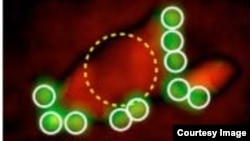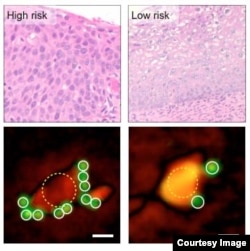A new smartphone-based device can diagnose the presence of cancer cells in a blood sample. The technology is so portable, it can be used in remote areas where more sophisticated equipment for cancer detection is in short supply.
Diagnosing cancer usually involves cell experts called cytologists, high-powered microscopes and other equipment. Cytologists look for cancer cells in a sample of blood or tissue obtained through a biopsy. Such technology and skilled personnel are not often available in rural settings, especially in Africa or Asia.
But researchers at Massachusetts General Hospital in Boston have streamlined the process with a smartphone device that anyone can be trained to use.
In a study involving 25 cell samples from women suspected of having cervical cancer, the cellphone's tiny camera came up with a preliminary diagnosis within 45 minutes.
And it did so with near 100 percent accuracy, distinguishing "high risk" cells from "low risk" and non-cancerous cells.
Cesar Castro, a Mass General medical oncologist and the study’s lead author, said the phone records shadowy, holographic-type images that are sent to a computer and deciphered remotely.
"The images get sent to a remote server ... through the wireless system," Castro said. "And a computer does the graphically intense processing that recreates a pretty much high-resolution image of the cells, and then potentially the presence of beads."
Microscopic beads are added to the blood sample collected in a cube-shaped module tightly attached to the phone.
The microbeads contain targeted antibodies, or proteins, that seek out cancerous cells. If they find any, the beads adhere to proteins on the outside of the cancerous cells.
The small cube attached to the smartphone is called D3, short for digital diffraction and diagnosis system. It uses a battery-powered LED for illumination and is able to capture data from more than 100,000 cells in a sample.
The test, according to Castro, can be performed by just about anyone anywhere, "in your local primary care office" or even at home. It uses small samples such as a pinprick of blood, "like the amount of blood that a diabetic would secure in order to read how high their sugars are," he added. "… We’re working on another alternative specimen such as urine or saliva."
The test is inexpensive, costing about $1.80 for the module, battery and microbeads, Castro said.
An article describing the D3 cancer-detecting system was published Monday in the journal Proceedings of the National Academy of Sciences.









